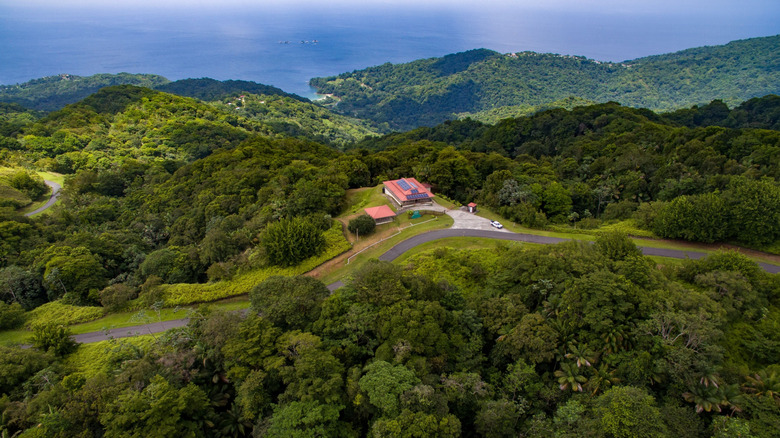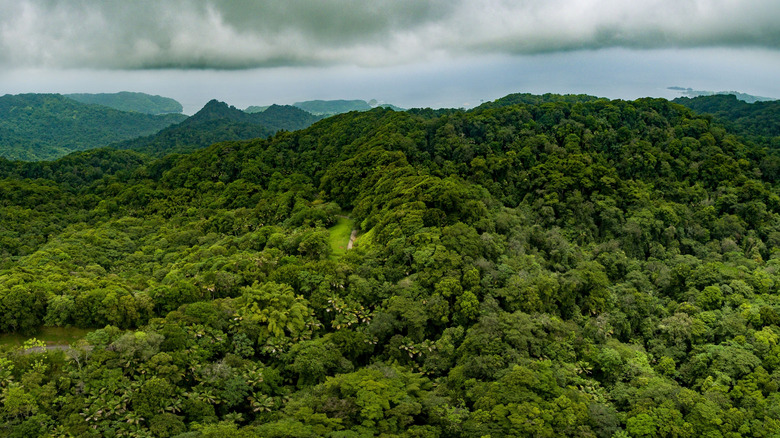The Oldest Protected Rainforest On The Western Hemisphere Is An Immaculate Caribbean Hiking Paradise
When most people think of the tropics, stunning Caribbean beaches with aquamarine water, white sand, and coconut palms often come to mind. But, there are many more sides to this corner of the world. The largest protected area in Grenada, for example, is a whopping 3,000 acres of dense jungle with crater lakes and gushing waterfalls. The Caribbean's wildly underrated Emerald Isle has smoking volcanos and birding reserves. Then there's the Main Ridge Forest Reserve of Trinidad and Tobago, which reigns as the oldest protected rainforest in the entire Western Hemisphere.
Encompassing nearly 10,000 acres of thick jungle, the area is draped over the peaks of central Tobago, the smaller of the two main islands in the country. A winding, weaving road leads to the heart of the reserve — the drive is roughly an hour from Scarborough, the capital of the island. Alternatively, there are day trip packages that often include guided walks, birdwatching, and stops at nearby waterfalls elsewhere on the island.
What awaits is a rainforest wonderland known for its evergreen canopy and booming biodiversity. Spilling down from heights of over 600 meters above sea level, it's a very different scene than the sugar-colored sands of Tobago's coast. Here, you'll hike amid groves of rosewood trees and big ferns, spot in excess of 200 species of birds flitting through the air, and explore one of the oldest areas of conservation on the globe.
Main Ridge Forest Reserve, then and now
As the oldest protected tropical rainforest in the Western Hemisphere, the Main Ridge of Tobago is full of history. The story goes that when the island was under British occupation, a parliamentarian by the name of Soame Jenyns recognized that the jungles played an essential role in supporting the island's ecosystem, which in turn helped improve conditions on the sugar plantations. He put together a proposal for the establishment of a nature reserve in 1776, and the plan was approved.
To put that into perspective, Main Ridge Forest Reserve gained protected status nearly 100 years before the formation of the first national park in America, and 174 years before even a single national park had been established back in Jenyns' native U.K. Main Ridge is one of the pioneering sites of modern environmentalism, and a visit here is both meaningful and memorable.
Today, the reserve is famed globally for its array of flora and fauna, including rare hummingbirds, coral snakes, tree frogs, and more. Main Ridge is now a part of the larger North-East Tobago UNESCO Biosphere Reserve, a vast 206,303-acre territory with a whopping 1,774 species within its boundaries.
Incredible hiking in the Main Ridge Forest Reserve
Hiking is one of the top ways to experience the Main Ridge and there's one trail that stands out from the crowd: The Gilpin Trace Trail. Local wildlife expert Newton George considers it one of the main highlights of Tobago. "It's very easy and also very biodiverse, from the plants and the insects to the native trees," said George in an interview with National Geographic.
The Gilpin Trace Trail takes roughly two hours in all and travels along the Bloody Bay River. Along the way, the trail offers glimpses of multiple waterfalls. There are plenty of opportunities to spot the various hummingbirds that live in this part of the forest, including the rare white-tailed sabrewing, the largest hummingbird in Tobago. The highest waterfall in Tobago is also within close proximity. Cue Argyle Falls, located a short distance away from the Roxborough Visitor Service Co-op. The 1.1-mile marked trail culminates with a view of the 157-foot cascade surrounded by wild jungle.
George recommends visiting Main Ridge Forest Reserve during Tobago's dry season between January and May, when more of the island's flora is in bloom. The dry months also usher in a period of more comfortable weather for outdoor activities such as birdwatching and hiking. Just don't expect the trails to be empty at that time, since it's also peak season in this part of the Caribbean.


